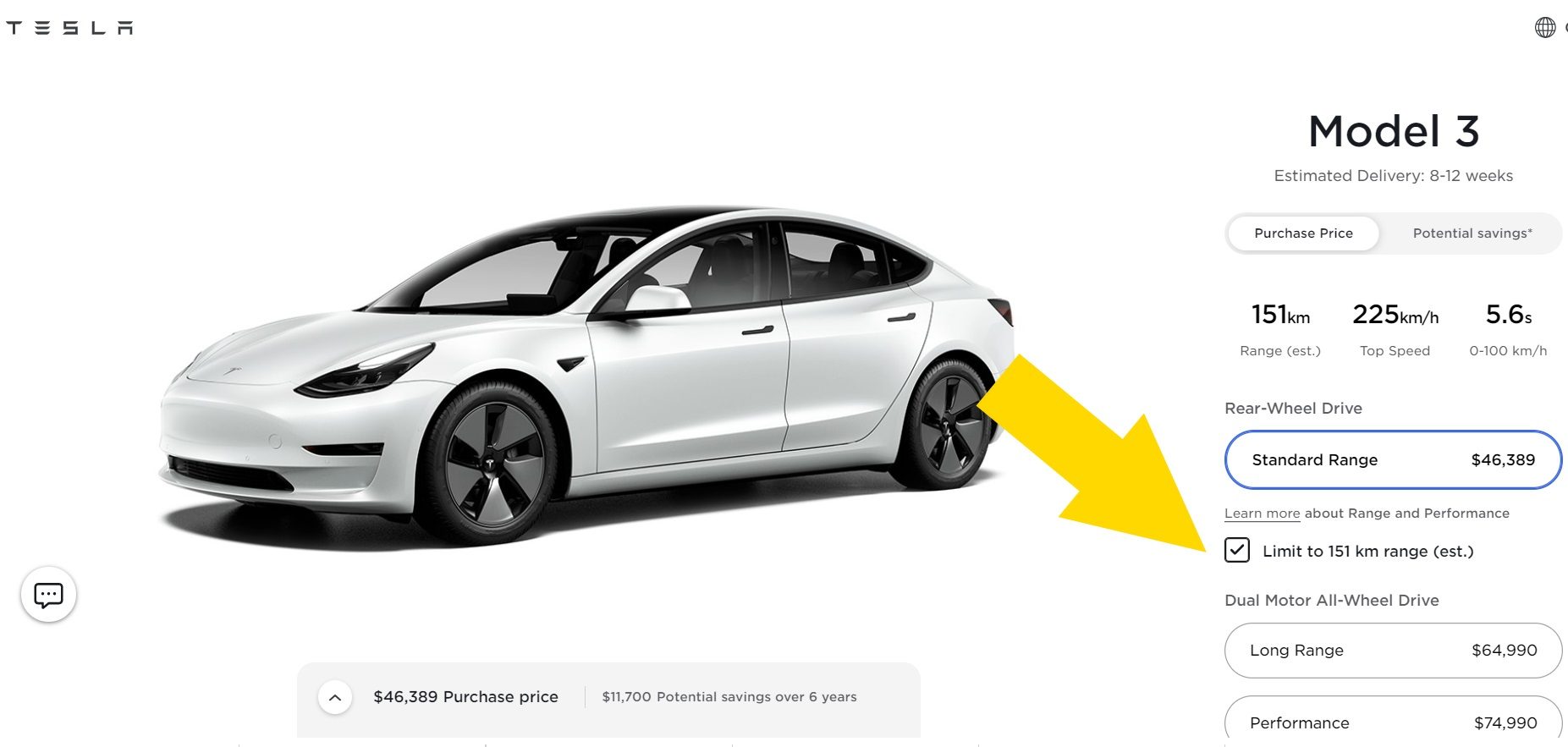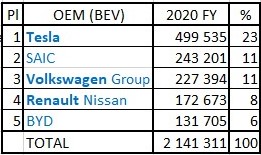
 |
VW Groep gaat ook naar bidirectioneel laden van hun EVs, 2022 ergens.
Dus de EV kan ook vermogen leveren aan andere ver- of gebruikers of naar het net (V2G) Andere merken doen het al of hun hardware is al voorbereid, t.t.z. enkel een software-aanpassing. Citaat:
|
Voorlopig grootste snellaadstation komt in Coalinga, CA. (Harris Ranch)
Er staan reeds 18 Tesla Sucs V2 (150 kW) maar er komen er nog minstens 80 bij (V3 250 kW), in geel kader op luchtbeeld. Dus vermoedelijk ~100 totaal. Bron: Citaat:
|
Tesla Canada omzeilt een domme subsidieregeling door een model 3 aan te bieden in de katalogus die niemand gaat kopen, want gekastreerd naar 151 km rijbereik en zonder basis autopilot.
 of Canada-Tesla configuratie: https://www.tesla.com/en_ca/model3/design#overview Maar dit levert volgens de ambetantenarenregeltjes wel op dat de normale versie met 426 km bereik toch een subsidie van 5000 Canadese dollars krijgt. Benieuwd hoelang dat gaat duren. Of hoe subsidieregels ook vindingrijk maken (was in België ook ooit met het vermogen via software wat af te pitsen, om hogere wegtaks te vermijden) Uitgelegd: https://www.autoblog.nl/nieuws/gehei...-geheim-882994 |
Toekomstige Autopilot FSD Beta software V 9.0 gaat werkelijk zonder radarinput zijn.
Tesla is niet alleen die dit doet, MobilEye testwagens reden rondom Jerusalem ook in die only vision configuratie. Elon Musk legt het in detail uit: Citaat:
|
https://insideevs.com/news/499095/ni...x-QUgMeFp6zqfM
The Nio ES6 started with 58 percent (247 km) of the battery left and finished the Nurburgring lap with 124 km left, or about 29 percent battery left. For a little comparison, a Tesla Model 3 Performance (in a completely separate video) started the Nurburgring with 91 percent battery and finished with 56 percent of the battery left. |
Wie kan de handschoen opnemen tegen Tesla?
Welke zijn de moeilijkste uitdagingen om een elektrische auto te assembleren, als - je weet hoe elektromotoren en batterijen gemanaged kunnen worden - als je leveranciers kent die merkongebonden onderdelen kunnen leveren? concreter: aan welke onderdelen kan je moeilijk geraken? Of is het assembleren de grootste moeilijkheid? |
Citaat:
De flessehals is de massaproductie van geschikte batterijcellen, want met de komst van de electrische auto en opslag van hernieuwbare energie moet de productie sowieso serieus omhoog. En sowieso daar produceren waar de meeste BEV verkocht worden en-of meer hernieuwbare opslag dringend nodig is. Ook dat is een grote kostenfactor waar nog veel rek op zit (vooral Europa) Het aantal batterijfabrieken zal serieus moeten toenemen, wat ook aan het gebeuren is. Wereldwijd bekeken: moesten "de grote moderne landen" zoveel batterijfabrieken hebben zoals **China gemiddeld heeft (77% LIB** productie) mag die flessehals er niet meer zijn. Bovendien gaan de batterijcellen nog verder evolueren zodat er steeds minder (kostbaar) materiaal nodig is per kWh. Volume en gewicht dalen verder per kWh. Elon Musk zei het eens bij de bouw van hun eerst Giga-batterijfabriek in Nevada, daarvan heeft de wereld er pakweg 100 nodig. Wie alle cijfers wil weten vind die ook hieronder. Europa sprecifiek zou 13 maal meer GWh moeten produceren tegen 2025. USA meer dan dubbel zoveel tegen 2025, enz... Citaat:
|
Je hebt autobatterijen, maar de andere batterijen zijn ook in opmars: er is ongeveer geen enkele huishoudelijk toestel, klein alaam, fiets .... meer die geen batterij heeft.
|
Citaat:
Daar komt heelwat actief temperatuurmanagement en monitoring bij kijken zodat de batterijcellen binnen de ideale temperatuurbandbreedte blijft ongeacht snel ontladen en ook laden. Zo nodig wordt het afgegeven batterijvermogen begrenst. Ook de batterijpacks die hernieuwbare energie opslaan - en in de regel 20 jaar garantie hebben - hebben die temperatuurgeregelde techniek met vloeistof. Men spreekt daarom van batterijpacks en hun BMS en niet van "passieve batterijen" zoals in een laptop. |
Veelbelovende verkoopscijfers in maart van Tesla model Y in China, slechts 3 maand na productiestart. (dus bijlange niet op volle productie)
Best verkochte E-SUV of meer dan driemaal meer dan de tweede beste NIO ES6. Zelfs op de algemene SUV-markt 4e best verkochte SUV met amper 2 E-versies. Maar weldra zijn ze ook daar de beste want ze hoeven enkel maar de maandcijfers van het model 3 te bereiken, die 2,5 hoger was dan het model Y. Citaat:
|
Citaat:
|
Ik heb net mijn winterbanden af laten doen, en nieuwe zomerbanden gekocht.
Wat small talk op anderhalve meter en met mondmasker vernam ik zo dat de bandenboer een stuk of vijf tesla's als klant heeft. En ook wat klein grut van bmw, bijvoorbeeld. Die hun banden slijten veel vlugger. Dat trekt goed op (die auto) dus trekken ze door (de chauffeurs). |
Citaat:
Aangezien banden uitharden mogen ze ook niet te lang meegaan anders worden ze onveilig. ;-) Citaat:
|
Citaat:
|
Mercedes EQS topmodel met meer dan 700 km rijbereik (770 km WLTP).
Ook dankzij bruikbare 108 kWh batterijpack en Cd van 0,20 Citaat:
Citaat:
De EQS is vooral de eerste electrische Mercedes die niet afgeleid is van een ICE-versie. Er komt ook een versie met 90 kWh accupack. |
Tesla nu ook nummer 1 in Frankrijk, 1e kwartaal 2021
9,3 % van alle stekkerwagens (incl. hybride) was een Model 3. Citaat:
Ook de plug-in hybrides gaan nog altijd vlotjes, bvb. van de Peugeot 508 waren 42% PHEV. De verhouding PHEV/BEV schommelt rond 50/50 in Frankrijk. De Fransen kopen vooral franse merken, bij (PH)EV gaat enkel Tesla zich (voorlopig) mengen. En het model Y komt er ook nog bij als Tesla Berlijn wagens gaat leveren. |
Citaat:
Niet iedereen wil altijd ~4 uur continu kunnen rijden. Daarenboven zal de gewone basis RWD-versie (met 333 PK) in de regel volstaan waar geen sprake is van echte winters, dat is duidelijk de zuinigste. Er zou later nog een performance-versie komen van 760 PK die heeft natuurlijk altijd AWD. "Halfweg" heb je de 526 PK versie, ook AWD. Wat me verrassend opviel is dat Mercedes 10 jaar garantie en-of 250.000 km op het batterijpack geeft. Dat kan Tesla niet zomaar laten voor hun nieuwe model S en X. Het zijn de redelijk nieuwe NCM 811 batterijcellen (sinds 2019) die ze gebruiken, maar andere merken zoals NIO, BMW, VW en andere gebruiken die ook. Maar de levensduur wordt ook door het BMS bepaald. NCM 811 staat voor een Nikkel-Cobalt-Mangaan-verhouding van 8-1-1 als kathodemateriaal. Daarvoor was er 622 en 523. Citaat:
|
EQS, wat een machine zeg. Geen spek voor mijn financiële bek. In mijn budget ben ik wel gecharmeerd door de Mustang. Zal mijne volgende worden.
|
https://www.autoedizione.nl/fiat-ver...TNCZQothNehxig
De briljante nieuwe elektrische Fiat 500. Binnenkort lees je meer over onze eigen ervaringen met deze nieuwe Fiat. Uiteraard heeft men in Turijn, net als iedere andere producent last van de pandemie, maar er is ook een positieve kant aan het verhaal. De productie kwam eind dit jaar geleidelijk op gang en heeft gedurende het eerste kwartaal van 2021 geresulteerd in maar liefst 2058 leveringen. Inmiddels staat sinds de lancering de teller op circa 8000 eenheden. Daarmee laat de elektrische Fiat 500, Tesla ver achter zich op Italiaanse bodem. Fiat is een nieuwkomer op dit terrein, maar toont duidelijk dat het over een gigantische expertise beschikt. De elektrische 500 is een hoogwaardig product met geweldige rijeigenschappen. |
Binnenkort 1 miljoen stuks verkocht van het model 3 na ~3,5 jaar. (sinds Q4-2017 op de markt)
Tweede is de Nissan Leaf, die wel ~7 jaar eerder op de markt kwam, haalt ~500k of de helft totnutoe (ondertussen 5e generatie) Citaat:
Alle Tesla-modellen zouden dit jaar 2 miljoen kunnen halen (sinds 2012, zie grafiek). Citaat:
|
Citaat:
|
|
Dit is ook reclame:
Top 10 van de wagenmodellen met het minste waardeverlies. 2 EV staan er bij. Tesla model 3 en Porsche Taycan. https://www.whatcar.com/news/the-10-...rs-2021/n17098 |
0 tot 100 kmh in 1,1 seconde met SpaceX optie voor de nieuwe Roadster.
 https://www.teslarati.com/tesla-road...ime-confirmed/ Dat is 2,5 g. Hold my beer. |
Rocket thrusters. Da's een dragrace car.
|
Citaat:
Voor veiliger een 4-vaksbaan met brede middenberm over te steken. lol. Of een breed kruispunt als er nog iemand vanuit de zijkant door het rood glipt. Of een 16-meter vrachtwagen bij 2/3-inhaalweg sneller in te halen als er iemand de rijbaan opdraait zonder naar rechts te kijken. ... Of voor de politie en noodtransport |
De 1,1 seconde naar 100 kmh optie komt er.
Bevestigingstweet : Citaat:
|
Tesla opent in China eerste V3-laadstation van in Shanghai gemaakte Superchargers. V3 = laden tot 250 kW.
https://www.teslarati.com/tesla-made...harger-photos/ |
Citaat:
Citaat:
https://europe.autonews.com/automake...percars-ev-era |
Tesla wordt autoverzekeraar (voor Tesla's).
Helemaal gepersonaliseerd op uw rijstijl. Metert hoeveel afstand je gemiddeld houdt van voorligger, hoe vaak je over een lijn gaat enz... Alles fully automatic. https://www.youtube.com/watch?app=desktop&v=yAM9PU1ZrBo |
Citaat:
Niet alle verzekeringen honoreren dit. Tiens men kan ook zelf die EDR-data uitlezen tegen een prijsje voor de hardware: https://www.teslarati.com/tesla-edr-...-data-support/ Dus niet-Tesla-verzekeringen kunnen dat dan ook. |
Tesla model 3 klimt ook in Frankrijk naar nummer 1 als bestverkochte (PH)EV, dus alle stekkerwagens. (8.083 op 5 maanden 2021)
Citaat:
Citaat:
2019: 3% 2020: 6,7% 2021 YTD: 7,1% enkel mei 2021: 8,2% Is een oneerlijk vergelijk maar de dieselpersonenwagen had 25 jaar nodig (1960-1985) om in Duitsland van 3,3 % naar 9 % te geraken. :-P |
Tesla Plaid badge :-)
Citaat:
|
PK-curve van de 3 Plaid-motoren. Draait +20.000 rpm max... (begrenzing 322 kmh)
Citaat:
Laden gaat nu ook sneller, tot 300 km erbij in 15 minuten. Maar de huidige 250 kW-laadzuilen kunnen nog upgrades aan, indien nodig. Citaat:
|
|
Citaat:
|
Wie duwt Tesla is realiteit :-P |
Tesla zorgt voor 25 % BEV-wereldmarkt in eerste kwartaal 2021.
 https://www.jato.com/q1-2021-ev-glob...-year-figures/ |
https://twitter.com/i/status/1404532078079795202
:lol: Plaid op circuit, inhaalmaneuver, zet geluid aan... https://twitter.com/i/status/1404513760643932160 |
General Motors gaat $ 35 miljard investeren in EV en autonoom rijden.
Streeft meer dan 1 miljoen EV per jaar te verkopen tegen 2025. Citaat:
 Aan marktkapitalisatie wipt GM nipt naar vijfde plaats voor BYD (verloor wel -8,2%), ook dankzij die aankondiging (+2,14%): Citaat:
Want SAIC heeft daar 50,1% aandeel en die tellen die mini EV alvast wel mee. https://de.wikipedia.org/wiki/SAIC_GM_Wuling Nach Angaben von General Motors China galten im Juli 2020 die folgenden Anteile: 50,1 % SAIC Motor, 44 % General Motors China und 5,9 % Guangxi Automobile Group (vorher Wuling).[8 : https://www.gmchina.com/company/cn/e...gm-china.html] Citaat:
|
| Alle tijden zijn GMT +1. Het is nu 20:11. |
Forumsoftware: vBulletin®
Copyright ©2000 - 2025, Jelsoft Enterprises Ltd.
Content copyright ©2002 - 2020, Politics.be